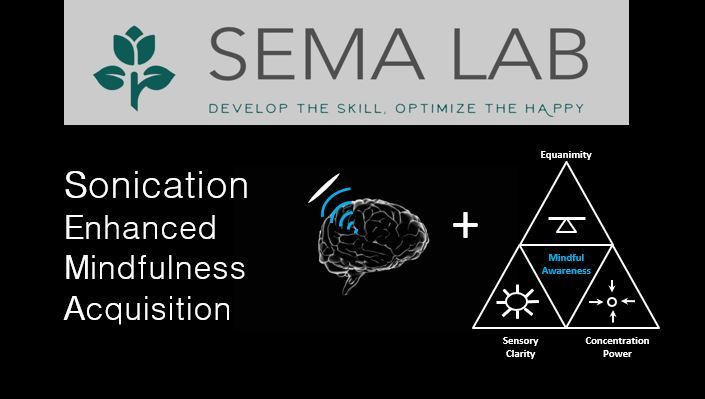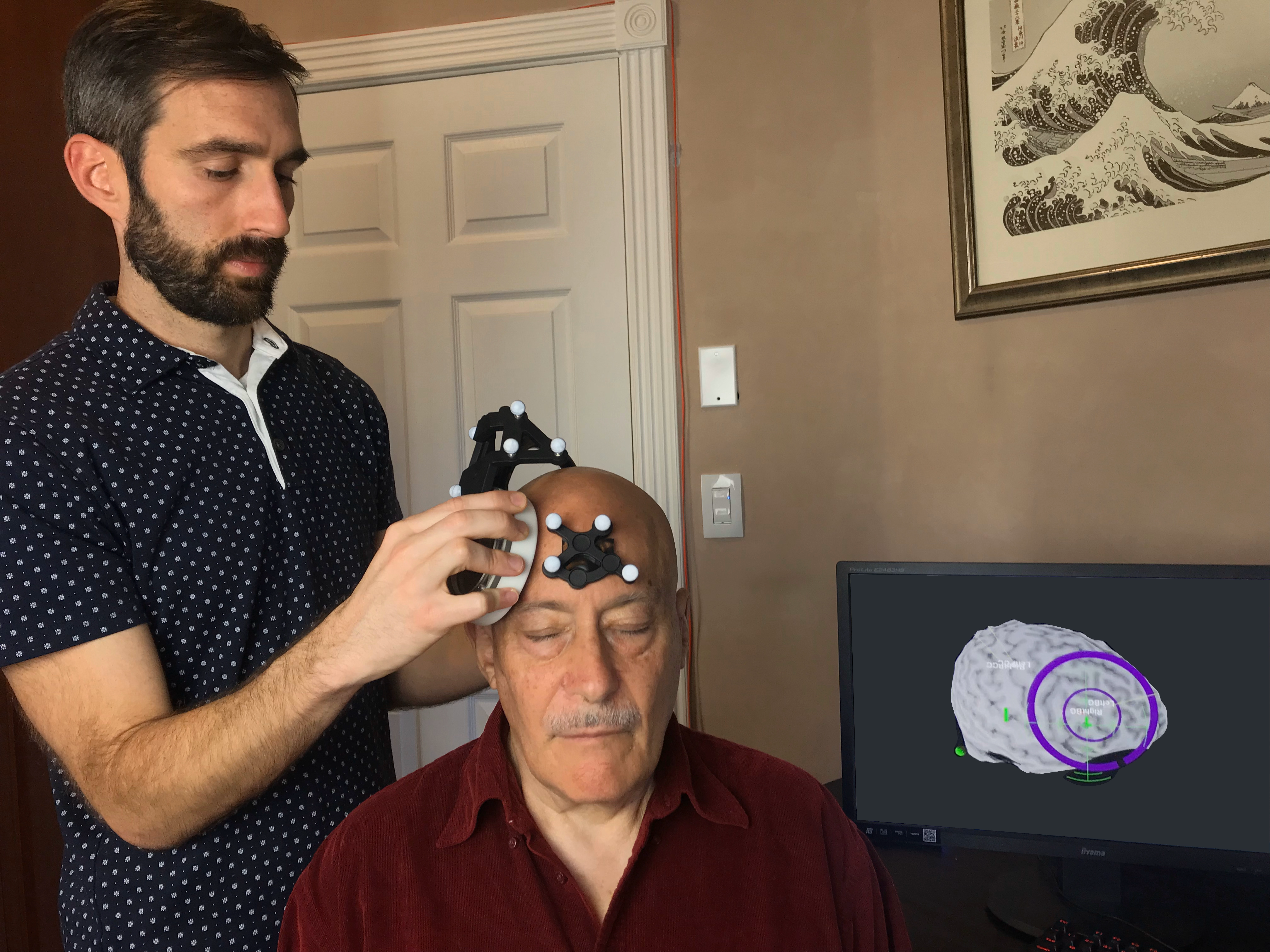Enhancing Mindfulness Training
SEMA lab at the Center for Consciousness Studies is happy to announce a new crowdfunding campaign
Help SEMA lab fund a brain imaging and neurostimulation experiment targeting the Default Mode Network - a central area that may be involved in mindfulness training.
Enhancing Mindfulness Training Project

SEMA Lab - CCS-UA
Dr. Jay Sanguinetti, Co-Director of SEMA Lab and Associate Director of the Center for Consciousness Studies
Jay Lacoste Sanguinetti is the associate director of the Center for Consciousness Studies and a research assistant professor in the College of Social and Behavioral Sciences. Sanguinetti specializes in psychophysiological measures (EEG, fMRI, eye-tracking) of visual perception, emotion, and mindfulness meditation. His current research includes using noninvasive brain stimulation to enhance cognition and well-being. Sanguinetti recently co-launched the Sonication Enhanced Mindful Awareness (SEMA) lab to develop accelerated mindfulness protocols for therapeutic interventions to treat addiction, chronic pain, and depression.
SEMA lab is focused on accelerating mindfulness training with ultrasound (or other technologies).
At the SEMA Lab (Sonication Enhanced Mindful Awareness), we seek to solve a common obstacle faced when applying mindfulness practice to clinical populations: Mindfulness meditation is sometimes simply too difficult for those that could benefit the most from it.
Mindfulness has been shown to improve outcomes for a whole host of disorders, such as chronic pain, depression, anxiety, eating disorders, addiction… the list goes on. Despite its effectiveness, compliance with mindfulness protocols in clinical populations tends to be low, perhaps due to the immense effort and time it takes to start seeing benefits of the practice. This is an unfortunate paradox keeping these populations from experiencing the life-changing effects the practice can have: In essence, mindfulness can free someone of their disorder, but the disorder keeps them from committing to the practice.
How do we solve this problem? With SEMA, we can make mindfulness more rewarding at the beginning of the practice, so that the practitioner continues to apply meditation training. With this approach, the barriers to commitment and consistent practice become lessened, and the practitioner is free to explore the life-changing effects that mindfulness has to offer.
How can we make mindfulness more rewarding? We’re using a new form of noninvasive brain stimulation called transcranial ultrasound (TUS). TUS uses low-intensity ultrasound to safely and reversibly modulate brain activity and is quickly gaining traction as a tool for neuroscience. When we ultrasound a part of the brain, we call that “sonicating” the brain. TUS can be focused, allowing us to sonicate relatively specific parts of the brain. We are aiming the ultrasound to a part of the brain that we think should help enhance the acquisition of meditation skills (like equanimity, concentration, and sensory clarity) and participants will receive sonication while they meditate. Thus, we are not seeking to replace meditation — participants will still have to do the hard work. But we hope this paradigm will help them learn the meditation techniques quicker and benefit from the practice sooner.
This research is in the early stages. So far, we have run pilot experiments that have been encouraging, but we must do more to validate these results. In SEMA lab at the University of Arizona, we are currently launching several experiments to examine the efficacy and safety of the sonication enhanced mindfulness. We will be submitting these results to peer-reviewed journals as soon as the experiments are completed. Check back soon for updates.
Want to learn more? Download our one-pager, check out Jay’s TEDx Talk below, or listen to Shinzen’s podcast here.
Jay Sanguinetti - TEDx: https://www.youtube.com/watch?v=rGEjmwaIPZk
Shinzen Young - podcast: https://www.soulspacepodcast.com/category/mindfulness/
SBS - Downtown Lecture Series - Tucson - 2021

ARE OUR BRAINS WIRED FOR COMPASSION? The Science Behind Caring for Others
October 13, 2021| 6 PM
Jay Lacoste Sanguinetti
Our brains appear wired to respond to the suffering of others. In fact, our reward circuits fire when we alleviate suffering. The emerging neuroscience of compassion has begun to reveal our innate need to care for others and how this ability has helped us survive. But the story does not end there. Cultivating compassion through training practices like meditation activates brain circuits related to positive emotion, reduces stress, and leads to overall well-being.
In this talk, Jay Lacoste Sanguinetti, associate director of the Center for Consciousness Studies, will explore the fascinating new science of compassion and how intentional cultivation of this important ability may have wide-ranging impacts on our individual and societal health.
About the Speaker
Jay Lacoste Sanguinetti is the associate director of the Center for Consciousness Studies and a research assistant professor in the College of Social and Behavioral Sciences. Sanguinetti specializes in psychophysiological measures (EEG, fMRI, eye-tracking) of visual perception, emotion, and mindfulness meditation. His current research includes using noninvasive brain stimulation to enhance cognition and well-being. Sanguinetti recently co-launched the Sonication Enhanced Mindful Awareness (SEMA) lab to develop accelerated mindfulness protocols for therapeutic interventions to treat addiction, chronic pain, and depression.
Highlights:

Ultrasound Research at CCS: An Overview
Research Publications:
Transcranial Focused Ultrasound to the Right Prefrontal Cortex Improves Mood and Alters Functional Connectivity in Humans, Sanguinetti JL., Hameroff S., Smith EE., Sato T., Daft CM.,Tyler William J., Allen JJB, Frontiers in Human Neuroscience 28 February 2020 www.frontiersin.org › articles › fnhum.2020.00052 › full
Human Brain Stimulation with Transcranial Ultrasound: Potential Applications for Mental Health, Sanguinetti JL, Smith E, Allen John JB, Hameroff S, Bio electromagnetic and Subtle Energy Medicine, 2nd edition, CRC Press, pp 355-360, 13-08-2014.
Increased Excitability Induced in the Primary Motor Cortex by Transcranial Ultrasound Stimulation. Benjamin C. Gibson, Joseph L. Sanguinetti, Bashar W. Badran, Alfred B. Yu, Evan P. Klein, Christopher C. Abbott, Jeffrey T. Hansberger, and Vincent P. Clark, Front. Neurol., 28 Nov 2018 – Reference to: Sanguinetti JL, Smith E, Allen J, Hameroff S., Human brain stimulation with transcranial ultrasound. In Bioelectromagnetic and Subtle Energy Medicine Motor Cortex by Transcranial Ultrasound Stimulation (2014).
Non-invasive brain stimulation techniques aimed at mental and neurological conditions include transcranial magnetic stimulation (TMS) for depression, and transcranial direct current (electrical) stimulation (tDCS), shown to improve memory. Transcranial ultrasound stimulation (TUS) has also shown promise.
Mood disorders, Alzheimer’s disease, traumatic brain injury (TBI) and post-traumatic stress disorders (PTSD) are enormous problems for those afflicted, their families, caregivers and society in general. Current treatments for these disorders are modestly effective at best, and new, more effective and inexpensive approaches are needed. A major hurdle in treatment is the lack of understanding in mainstream approaches as to how the brain works normally, how mood, cognition, memory and consciousness derive from synaptic computation among neurons. However evidence now suggests mental states may depend, to some extent at least, on vibrations, e.g. sound wave solitons in neuronal membranes, and megahertz (‘MHz’, 106 to 107 Hz) resonances in microtubule networks inside neurons. In TBI and Alzheimer’s disease, microtubules are disrupted and release ‘tau’, a microtubule-associated protein. Under normal circumstances, microtubules are directly responsible for neuronal and synaptic growth, repair and plasticity.
Ultrasound (US) consists of mechanical oscillations, e.g. in MHz. ‘Transcranial ultrasound’ (‘TUS’) passes low intensity, sub-thermal US through the skull into the brain, safely and painlessly. In clinical trials, TUS improves human mood and cognition, and in lab studies megahertz stimulation promotes microtubule assembly. We propose to determine safety and efficacy of inexpensive and potentially portable TUS technology for improving recovery from TBI, Alzheimer’s disease.
Hypothesis or Objective: High intensity US can heat, cavitate and ablate kidney stones, brain tumors and other tissue. Mid-intensity US (‘diathermy’) causes mild heating, useful for musculoskeletal problems. Low intensity, ‘sub-thermal’ US (<720 mW/cm2 by FDA guidelines) excites peripheral neurons,4 and promotes their regeneration after injury. Applied at the scalp, low intensity TUS is FDA-approved for brain imaging, though supplanted by CT, MRI etc. TUS is still used to image brains of newborn babies through boneless fontanelles, and can be focused anywhere in the adult brain. WJ Tyler and others first showed low intensity TUS caused behavioral and electrophysiological changes in animals, and more recently cognitive enhancement in humans.
In the first TUS study on human mental states,11 our group showed that 15 seconds of 8 MHz TUS to fronto-temporal cortex from temporal scalp at 150 mW/cm2 resulted in 40 minutes of improved mood compared to sham exposure. Further studies12 have shown optimal mood improvement with 2 MHz TUS for 30 seconds to right fronto-temporal cortex. In some cases, vertex stimulation (targeting cingulate cortex) resulted in uncontrolled laughter, “out of body” experiences and feelings of being “more in the moment”. High frequency (gamma synchrony) EEG was increased near the TUS stimulation site.
Regarding cellular and molecular level mechanisms, Tyler suggested TUS promotes vibrations in a mechanical continuum of extracellular, intra-membrane and intra-neuronal structures. Among these are microtubules, self-assembling polymers of tubulin, the brain’s most prevalent protein. TUS might act by tuning or enhancing endogenous microtubule megahertz resonances.
Cellular damage in TBI is attributed to biochemical cascades, apoptosis, inflammation, free radicals, glutamate excitotoxicity, blood brain barrier breakdown, axon shearing, and cytoskeletal disruption. Regardless, neuronal recovery and synaptic formation require microtubule-dependent extension of axonal and dendritic ‘neurites’. TUS may stimulate neuronal repair (e.g. for TBI) and memory turnover (PTSD). TUS warrants clinical trials for TBI, Alzheimer’s disease and PTSD.
Research Strategy
Our previous TUS studies have used a clinical GE Logiq US imaging device, and the U+ single transducer TUS headset from Thync, Tyler’s company (formerly NeuroTrek). Both devices are limited in range of MHz frequencies for testing. We are collaborating with Sterling Cooley (Berkeley Ultrasound, Berkeley, California) who has developed a TUS device called the NeuroResonator 1 (NR1) which we tested and calibrated in October, 2014. Proposed modifications will upgrade to the battery-powered NeuroResonator 2 (‘NR2’) with multiple US piezo transducer/emitters with various lead placements, each emitter controlled individually, able to be aimed at particular brain areas, driven synchronously, sequentially, in any combination and/or pulse modulated, e.g. by music. The NR2 will be calibrated, tested, and reviewed and approved by our Bioengineering and Institutional Review Board. Stimulation sites will be selected based on injured brain area, right fronto-temporal and other areas. We plan pilot studies commencing early spring 2015 and will search for optimal techniques. With the NR2 fitting in an EEG cap, we will also study TUS effects on simultaneous EEG.
References cited
Heimburg T, Jackson AD. On soliton propagation in biomembranes and nerves Proc. Natl. Acad. Sci. U.S.A. 2005, 102 (2): 9790
Sahu S, Ghosh S, Ghosh B, Aswani K, Hirata K, Fujita D, Bandyopadhyay A. Atomic water channel controlling remarkable properties of a single brain microtubule: correlating single protein to its supramolecular assembly. Biosens Bioelectron. 2013 Sep 15;47:141-8. doi: 10.1016/j.bios.2013.02.050. Epub 2013 Mar 15.
Sahu S, Ghosh S, Hirata K, Fujita D, Bandyopahyay A. Multi-level memory-switching properties of a single brain microtubule, Applied Physics Letters (Impact Factor: 3.79). 03/2013; 102(12). DOI: 10.1063/1.4793995
Harvey EN, The effect of high frequency sound waves on heart muscle and other irritable tissues. American Journal of Physiology, 91. 1929 December 1, pp. 284–290
Raso, VVM, Barbieri CH, Mazzer N, Fazan VPS. Can therapeutic ultrasound influence the regener ation of peripheral nerves? Journal of Neuroscience Methods, v. 142, n.1, p. 185-192, 2005. DOI: 10.1016/j.jneumeth.2004.08.016
Park SC, Oh SH, Seo TB, Namgung U, Kim JM, Lee JH. Ultrasound-stimulated peripheral nerve regeneration within asymmetrically porous PLGA/Pluronic F127 nerve guide conduit. J Biomed Mater Res B Appl Biomater. 2010 Aug;94(2):359-66. doi: 10.1002/jbm.b.31659.
Tyler WJ, Tufail Y, Finsterwald M, Tauchmann ML, Olson EJ, et al. (2008) Remote Excitation of Neuronal Circuits Using Low-Intensity, Low-Frequency Ultrasound. PLoS ONE 3(10): e3511. doi:10.1371/journal.pone.0003511
Pearse A. Keane, Adnan Tufail, Praveen J. Patel. Management of Neovascular Age-Related Macular Degeneration in Clinical Practice: Initiation, Maintenance, and Discontinuation of Therapy, J Ophthalmol. 2011; 2011: 752543. Published online 2011 November 22. doi: 10.1155/2011/752543 PMCID: PMC3228281
Yoo SS, Bystritsky A, Lee JH, Zhang Y, Fischer K, Min BK, McDannold NJ, Pascual-Leone A, Jolesz FA. Focused ultrasound modulates region-specific brain activity. Neuroimage. 2011 Jun 1; 56(3):1267-75. Doi: 10.1016/j.neuroimage.2011.02.058. Epub2011 Feb 24.
Legon W, Sato TF, Opitz A, Mueller J, Barbour A, Williams A, Tyler WJ. Transcranial focused ultrasound modulates the activity of primary somatosensory cortex in humans, Nature Neuroscience 17, 322-329 doi:10.1038/nn.3620
Hameroff S, Trakas M, Duffield C, Annabi E, Gerace MB, Boyle P, Lucas A, Amos Q, Buadu A, Badal JJ. Transcranial ultrasound (TUS) effects on mental states: a pilot study, Brain Stimul. 2013 May;6(3):409-15. doi: 10.1016/j.brs.2012.05.002. Epub 2012 May 29.
Tyler WJ, Ultrasound for Neuromodulation? A Continuum Mechanics Hypothesis. The Neuroscientist 17(1), 2011, 25-36.
Raman, U, Gupta S, Parker S , Gupta N, Gupta AK, Duffield C, Ghosh S, Hameroff S. Low-intensity ultrasound (US) stabilizes microtubules and promotes neurite outgrowth. 2014. Ultrasound promotes neurite outgrowth-Implications for TBI – Nov 18, 2014, U.Raman, S.Parker, C.Duffield, S.Ghosh, *S. R. Hameroff
Transcranial ultrasound (‘TUS’) – an optimal non-invasive brain-machine interface via microtubules? Society for Neuroscience, SR Hameroff, JL Sanguinetti, C Duffield, U Raman, S Ghosh,S Parker, QD Amos, JJB Allen, November 14, 2013, Brain Stimulation Journal
Sanguinetti JL, Smith EE, Dieckman L, Vanuk J, Hameroff S, Allen JJB , Noninvasive Transcranial Ultrasound for Brain Stimulation: Effects on Mood in a Pilot Study, Psychophysiology 50, S36-S36 Psychophysiology 51, S42-S42. (2013) Abstract.
Presentations
Hameroff, Stuart. (with John JB Allen and Jay Sanguinetti. Department of Psychology, University of Arizona) ‘Transcranial ultrasound (‘TUS’) effects on mood and memory in human volunteers’ Presentation, 2nd International Brain Stimulation Conference, Barcelona, Spain, March 5-8, 2017
Hameroff, Stuart. Google Sci-Foo, Invited Speaker, 2016
-
a) Lightning talk – ‘Good vibrations – Tuning the brain with transcranial ultrasound’ Invited Speaker
-
b) ‘Quantum physics and consciousness’ (session on the future of physics with Max Tegmark and Nobel laureate Frank Wilczek), Google Campus, Mountain View, California, July 22-24, 2016.
U. Raman, S. Parker, C. Duffield S. Ghosh, SR Hameroff; Ultrasound promotes neurite outgrowth-Implications for TBI Neuroscience, Nov 18, 2014.
Hameroff, Stuart. ‘Low-Intensity Ultrasound Promotes Neurite Outgrowth in Cultured Cortical Neurons’ Brain Stimulation, Concurrent Speaker with Uma Raman, Sara Parker, Chris Duffield, Sourav Ghosh, The Science of Consciousness, Tucson, Arizona, April 23, 2014. p. 130 abstract 146
Hameroff, Stuart. ‘Ultrasound Vibrations Stabilize Microtubules In Vitro’ Brain Stimulation, Concurrent Speaker with Saatviki Gupta, Nandita Gupta; Arun Kumar Gupta, The Science of Consciousness, Tucson, Arizona, April 23, 2014. p. 202 abstract 284
Additional Media
Good vibrations: Mediating mood through brain ultrasound – Researchers have developed a novel technique to affect mood through ultrasound vibrations applied to the brain. Their findings could potentially lead to new treatments for psychological and full story, Science Daily, July 18, 2013
Non-invasive brain stimulation techniques aimed at mental and neurological conditions include transcranial magnetic stimulation (TMS) for depression, and transcranial direct current (electrical) May 15, 2013, Science Daily...full story
Mediating Mood Through Brain Ultrasound, UA News, July 16, 2013

